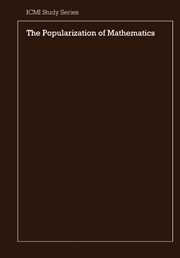Book contents
- Frontmatter
- Contents
- FOREWORD
- A Study Overview
- Mathematics in Different Cultures
- Mathematics for the Public
- Making a Mathematical Exhibition
- The Role of Mathematical Competitions in the Popularization of Mathematics in Czechoslovakia
- Games and Mathematics
- Mathematics and the Media
- Square One TV: A Venture in the Popularization of Mathematics
- Frogs and Candles - Tales from a Mathematics Workshop
- Mathematics in Prime-Time Television: The Story of Fun and Games
- Cultural Alienation and Mathematics
- Solving the Problem of Popularizing Mathematics Through Problems
- Popularizing Mathematics at the Undergraduate Level
- The Popularization of Mathematics in Hungary
- Sowing Mathematical Seeds in the Local Professional Community
- Mathematical News that's Fit to Print
- Christmas Lectures and Mathematics Masterclasses
- Some Aspects of the Popularization of Mathematics in China
Mathematical News that's Fit to Print
Published online by Cambridge University Press: 26 April 2011
- Frontmatter
- Contents
- FOREWORD
- A Study Overview
- Mathematics in Different Cultures
- Mathematics for the Public
- Making a Mathematical Exhibition
- The Role of Mathematical Competitions in the Popularization of Mathematics in Czechoslovakia
- Games and Mathematics
- Mathematics and the Media
- Square One TV: A Venture in the Popularization of Mathematics
- Frogs and Candles - Tales from a Mathematics Workshop
- Mathematics in Prime-Time Television: The Story of Fun and Games
- Cultural Alienation and Mathematics
- Solving the Problem of Popularizing Mathematics Through Problems
- Popularizing Mathematics at the Undergraduate Level
- The Popularization of Mathematics in Hungary
- Sowing Mathematical Seeds in the Local Professional Community
- Mathematical News that's Fit to Print
- Christmas Lectures and Mathematics Masterclasses
- Some Aspects of the Popularization of Mathematics in China
Summary
The theme of this session – understanding new trends, new results - invites reflection on two small Anglo-Saxon words: “new” and “news.” “New” has several distinct meanings: not existing before; not known before; fresh; different; not old; of recent origin. “News” refers to tidings - to information about recent events.
The two words, in our context, reflect two professions: mathematician and journalist. Mathematicians deal with the new; journalists with news. Despite the common etymology of these words, in practice they have almost opposite meanings to the mathematician and the journalist. To understand new trends and new results, we have to examine how mathematicians and journalists differ in their perceptions of what's new and of what's news.
NEW MATHEMATICS
What is new to the mathematician? For some it is theorems - proofs of old conjectures or discoveries of new results. In 1983 it was Gerd Faltings' proof of the Mordell conjecture; in 1985 it was Louis De Branges' proof of the Bieberbach conjecture. In 1988 it was, for a short time, Yoichi Miyaoka's claim that he had proved Fermat's Last Theorem.
For others, what is new in mathematics are trends in research. For a good part of the 1970's, catastrophe theory was new; now attention has shifted to fractals and chaos. Forty years ago, many new trends in mathematics were expressed in the collective work of Nicholas Bourbaki as the culmination of David Hilbert's agenda to provide a complete logical portrait of known mathematical theory.
- Type
- Chapter
- Information
- The Popularization of Mathematics , pp. 176 - 193Publisher: Cambridge University PressPrint publication year: 1990

